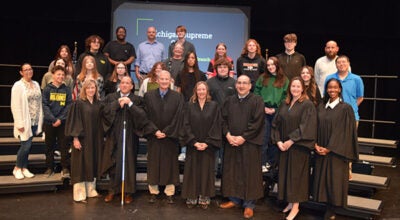Ferguson Michiana creates buzz with Michiana Wind Systems
Published 8:48 am Monday, April 19, 2010
By JOHN EBY
Niles Daily Star
Ferguson Michiana Inc., 7162 M-140 North, primarily subcontracts for AT&T, but just expanded into Michiana Wind Systems, distributing Century Wind Energy turbines.
“Ron stuck the sign out there Thursday night, then the traffic jam began,” Tracy Galbreath said Tuesday.
“(Berrien County) Farm Bureau next door is where all the farmers gather in the morning and they were all excited,” he said. “There are a lot of them investigating it and there are a lot of them interested in it.
“If you were selling popcorn, the place to set your stand up would have been out here with all the cars pulling over and taking cell phone pictures. The interest is there.”
The gleaming generator has 17.5 yards of concrete in its foundation – two truckloads.
It’s 49 feet tall – 41 feet of shaft plus eight feet of blades.
Ferguson Michiana hopes to reduce its $800 monthly electric bill by a third.
AEP advised them there are “60 or less” wind generators in Berrien County and northern Indiana.
Michiana Wind Systems involves David Ferguson, Tracy Galbreath and her husband, Ron, who is a Dowagiac Union School District bus mechanic.
Tracy used to work in the car business in Dowagiac, which she left almost 10 years ago in October 2000 for “the dirt-digging business.”
The Galbreaths live on M-51 South in Pokagon Township. Tracy graduated from Union High School in 1981. Ron, who grew up in Niles and graduated from Brandywine High School.
Ferguson does directional drilling, cable and duct construction and aerial/underground from St. Joseph across northern Indiana, from Michigan City to South Bend and Elkhart.
“We basically do what AT&T needs, which is just about everything,” Ferguson said. “Manholes, boring, cable, fiber we run into all the South Bend businesses. We don’t do excavating.”
Ferguson Michiana was established by Dave’s dad R.C. in 1971.
Originally, it sold a machine that split the ground to put in sprinkler lines.
“He had five boys, so I think he decided with all the cable we were putting in the ground, we were a cable company,” Ferguson said. “We migrated into backhoes and machinery and bigger plows that slice the ground.”
The original sod cutter looks like a grasshopper and is displayed in the showroom, which also contains Cuthbert Insurance Agency.
“We just connected all the South Bend schools with fiber,” Tracy said. “Last year we spent all summer at Eddy Street Commons across from Notre Dame.”
“The wind company we hope will be a complement to help the underground company grow,” Dave said.
Ferguson slices the fledgling market into three categories: “small wind. We’re small wind. We’re an individual resident, farm or small business and five, 10 and 20 kilowatt. Then there’s community – bigger towers serving 25 or 50 homes. Then there’s big wind, the power company energy farms where they decide part of their power will come from wind.
“There are federal and state tax incentives and grants available until Jan. 1, 2017, for wind generator installations” which can help offset an investment of $28,000 to $30,000 by as much as 30 percent.
A smaller three-kilowatt generator can run $22,000 to $23,000.
“They’re not cheap,” Dave said, “but there is a payback. How bad do you want to go green?”
“What I’ve been hearing from customers,” Ron added, “is once they start going green, they start paying more attention to turning lights off and turning pools off during the day and just running them at night. Then all of a sudden they’re saving more money than they thought. It loosens cash flow when you’ve got that money in your pocket when your bill to the power company is smaller.”
Last November Ron and Dave attended a Detroit wind conference at which Gov. Jennifer Granholm appeared.
“These guys also went to township meetings for ordinance issues,” Tracy said.
“A lot of townships aren’t ready yet,” Dave said.
Silver Creek in Cass County and Pipestone in Berrien County have recently crafted ordinances regulating wind generation, “but as a general rule, I’d say way less than half even have an ordinance. I’ve been on websites with webinars held specifically to talk to townships about what to do and how to prepare. It’s a stumbling block right now, though a lot of them are working on them because they know it’s coming.”






